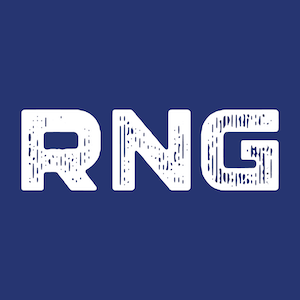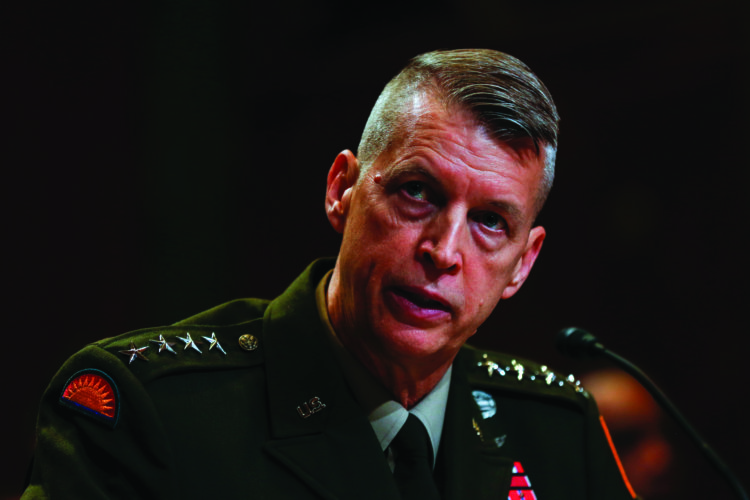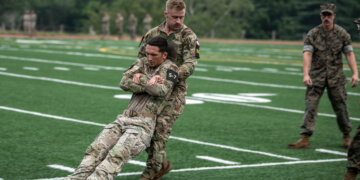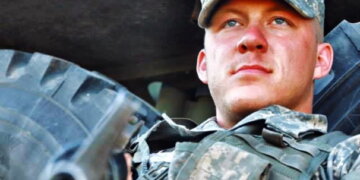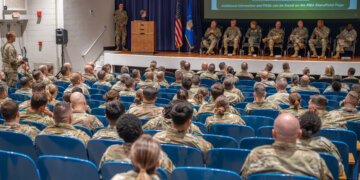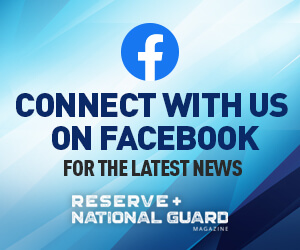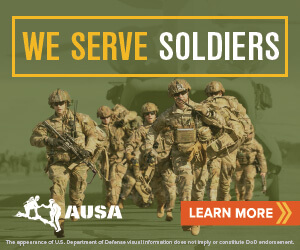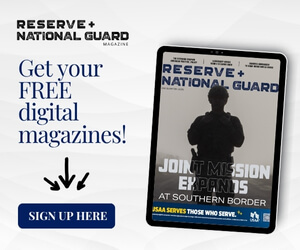The Chief of the National Guard Bureau said health care access for guardsmen is his highest priority in 2023.
Approaching the two-and-a-half-year mark of his tenure, Army Gen. Daniel Hokanson said he remains committed to four areas on behalf of 443,000 men and women serving in the National Guard: People, readiness, modernization and reform. At the top of his concerns, he says, is connecting “every single person” to health care. The National Guard Bureau estimates the number of those benefiting from such a change would be roughly 60,000.
“I look at what we’ve asked them to do over the last 20 years, and particularly over COVID. We sent these young men and women into an environment we really didn’t understand at first,” Hokanson said. “ … If we can provide health care to every single one of the service members … their family knows if anything happens — if they get injured at work or in their military career — we’re going to take care of them.”
While guardsmen receive health care while on orders, it’s the gaps in coverage Hokanson advocates for because soldiers and airmen are oftentimes activated with short notice.
“If they don’t have that preventative health care and can’t get the help they need, now they can’t perform their job and we’re losing a valuable resource,” Hokanson said. “But if we can provide that health care to every single guardsman … it would be a great retention tool, and I think it would be a great recruiting tool for companies to know, if I hire this person, they’ve got their own health care.”
As service branches continue to struggle with recruiting and retention, Hokanson’s conversations with recruiters reveal competition for employees is great. He said civilian employers have increased benefit offerings because the employment landscape demands it, making expanded health care access another tool to aid with attracting and maintaining force readiness.
National Guard leaders are also evaluating lessons learned from the COVID-19 pandemic, including telework opportunities that remove geographic barriers to talent. In October 2019, when Hokanson was director of the Army National Guard, he suggested allowing 10% of the workforce to telework. By March of the next year, the pandemic forced 90% of personnel to work from home.
“We learned we can do some things virtually, and we learned there’s some things we cannot do virtually,” he said.
Since becoming chief, he said they have looked at positions, like in the National Capital Region, that would allow guardsmen to lend their expertise to the job without requiring them to live in a high-cost area.
“By identifying these positions, we can get people with incredible talent to perform at the national level but not give up all those things that would prevent them from coming here,” he said. “Sometimes it’s the difference between them staying in and getting out. If we can find a middle ground to manage our talent and take care of them, we want to do that.”
Building awareness of the Guard’s integral role in the National Defense Strategy is another priority for Hokanson, who recently told division and unit commanders and senior enlisted leaders in January, “we need to tell our story.”
High-profile domestic missions placed soldiers and airmen at the front lines of American communities over the past three years, but Hokanson said he works with public affairs to remind those at every level “the reason we have a National Guard is to fight and win our nation’s wars.”
Its State Partnership Program, which now includes 85 partners, also puts the Guard at the center of U.S. relationships around the globe.
Ukraine is a great example, Hokanson says, of the value of working together proactively with other countries.
“We’ve been partners with them [Ukraine] for 30 years. California National Guard has been training with them all that time. When you look at when Russia invaded Crimea or in the Donbas in 2014, after that we sat down with the Ukrainians and said, ‘What did you learn? How can we help make you better?’” he said. “And so we setup a training unit in Lviv.”
Since 2015, active-duty service members then guardsmen have trained Ukrainian forces at the Combat Training Center-Yavoriv. Just days before Russia’s invasion in 2022, U.S. troops were pulled from Ukraine and sent to Germany to continue that training.
Hokanson credits America’s work with Ukraine as one of the reasons it continues to defy expectations against Russian forces.
“What we saw is a lot of people thought Ukraine would only last a week [after the Russian invasion], but folks in the Guard who had been training them said, ‘Not so fast.’ They’ve been paying attention. They learned from 2014 and they’re really good — and we’ve seen that,” he said. “It’s really a brutal fight, but I think it’s all due to the patriotism of the Ukrainians, willingness to stand up for their country and the training we did that has made a difference.”
Other state partnerships demonstrate how mutually beneficial it is to both guardsmen and international forces to learn from one another.
“You can’t surge trust,” Hokanson said. “If you have a 10-, 20-, 30-year relationship, our young soldiers and airmen have grown up with them. Our states and their countries become very close-knit and our guardsmen learn a lot from them, they learn a lot from us. We not only learn to operate in other environments but we also have a shared interest in trying to make sure our countries remain stable.”
Read comments

